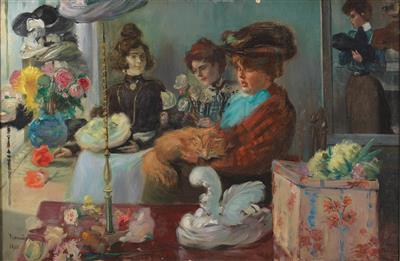Pierre George Jeanniot

(Geneva 1848–1934 Paris)
At the Milliner’s Salon, signed, dated Jeanniot 1901, oil on canvas, 54.5 x 81.5 cm, framed (minor damage to frame), (Rei)
Pierre-Georges Jeanniot’s artistic career couldn’t have enjoyed a more auspicious start: he was a talented illustrator and son of the long-time director of the École des Beaux-Arts in Dijon, Pierre-Alexandre Jeanniot (1826–1892).
He brought his military career to an end in 1883 with his decision to become an artist. He settled in Paris, initially working as an illustrator before gradually developing his painting. Despite initial successes at the Paris Salon where he was distinguished with medals and honourable mentions for his military motifs in a French realist style, he remained exceptionally receptive to the growing Impressist trend and its protagonists.
He became friends with Eduard Manet and Edgar Degas, as well as many major names in the Parisian art scene, underscoring the artist’s efforts to establish himself away from the world of salon painting. It was probably Manet himself who encouraged Jeanniot to give up his military career in favour of painting. The art critic Louis Vauxcelles reported that, during his time as an officer, Jeanniot had the opportunity to show Manet several of his works, with Manet responding, “My dear friend, you are one of us”, a reply which filled Jeanniot with immense pride (Louis Vauxcelles writing under the pseudonym Pinturicchio, in: Le Carnet de la semaine, Le Caret dans ateliers: Le Roi Lear; Les Vivants de la Collection; Les Manets de la Collection, Vol.4, no.148, 7 April 1918, p.8). However, over the coming years it would be Edgar Degas who was Jeanniot’s most influential companion: he was the artist upon which Jeanniot oriented his artistic oeuvre, whom he visited regularly at his home in Dienay près Is-sur-Tille (Côte-d’Or), and who collected Jeanniot’s paintings. Jeanniot’s portraits of Parisian women of the Belle Epoque, as in this scene at the milliner’s salon, offer us an exceptionally lively view of contemporary French society, and are a wonderful depiction of life in Paris amongst the sophisticated elite.
Esperta: Mag. Dimitra Reimüller
 Mag. Dimitra Reimüller
Mag. Dimitra Reimüller
+43-1-515 60-355
19c.paintings@dorotheum.at
21.04.2016 - 18:00
- Stima:
-
EUR 7.000,- a EUR 10.000,-
Pierre George Jeanniot
(Geneva 1848–1934 Paris)
At the Milliner’s Salon, signed, dated Jeanniot 1901, oil on canvas, 54.5 x 81.5 cm, framed (minor damage to frame), (Rei)
Pierre-Georges Jeanniot’s artistic career couldn’t have enjoyed a more auspicious start: he was a talented illustrator and son of the long-time director of the École des Beaux-Arts in Dijon, Pierre-Alexandre Jeanniot (1826–1892).
He brought his military career to an end in 1883 with his decision to become an artist. He settled in Paris, initially working as an illustrator before gradually developing his painting. Despite initial successes at the Paris Salon where he was distinguished with medals and honourable mentions for his military motifs in a French realist style, he remained exceptionally receptive to the growing Impressist trend and its protagonists.
He became friends with Eduard Manet and Edgar Degas, as well as many major names in the Parisian art scene, underscoring the artist’s efforts to establish himself away from the world of salon painting. It was probably Manet himself who encouraged Jeanniot to give up his military career in favour of painting. The art critic Louis Vauxcelles reported that, during his time as an officer, Jeanniot had the opportunity to show Manet several of his works, with Manet responding, “My dear friend, you are one of us”, a reply which filled Jeanniot with immense pride (Louis Vauxcelles writing under the pseudonym Pinturicchio, in: Le Carnet de la semaine, Le Caret dans ateliers: Le Roi Lear; Les Vivants de la Collection; Les Manets de la Collection, Vol.4, no.148, 7 April 1918, p.8). However, over the coming years it would be Edgar Degas who was Jeanniot’s most influential companion: he was the artist upon which Jeanniot oriented his artistic oeuvre, whom he visited regularly at his home in Dienay près Is-sur-Tille (Côte-d’Or), and who collected Jeanniot’s paintings. Jeanniot’s portraits of Parisian women of the Belle Epoque, as in this scene at the milliner’s salon, offer us an exceptionally lively view of contemporary French society, and are a wonderful depiction of life in Paris amongst the sophisticated elite.
Esperta: Mag. Dimitra Reimüller
 Mag. Dimitra Reimüller
Mag. Dimitra Reimüller
+43-1-515 60-355
19c.paintings@dorotheum.at
|
Hotline dell'acquirente
lun-ven: 10.00 - 17.00
kundendienst@dorotheum.at +43 1 515 60 200 |
| Asta: | Dipinti dell’Ottocento |
| Tipo d'asta: | Asta in sala |
| Data: | 21.04.2016 - 18:00 |
| Luogo dell'asta: | Wien | Palais Dorotheum |
| Esposizione: | 09.04. - 21.04.2016 |
